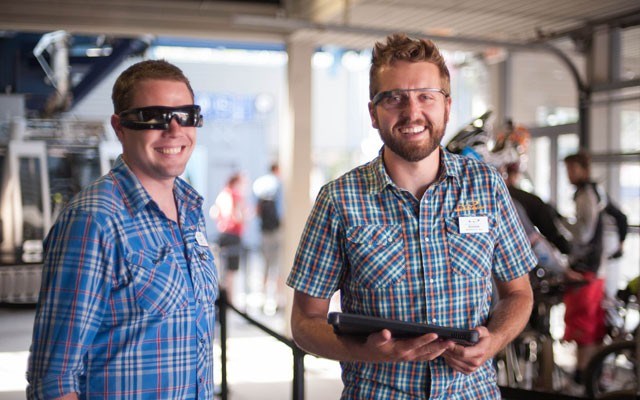Whistler Blackcomb (WB) is testing the waters of a hands-free future.
Building off of a community meeting at last year's GROW Conference — one of the tech industry's biggest annual gatherings — the mountain operator has partnered with Vancouver-based software company Vandrico Solutions to improve efficiency in its operations.
A pilot project involving wearable technology was launched on the mountain this week.
"If you boil it down, it's just a communication tool," said WB's VP of technology Mark Sedgwick.
"It allows us to communicate any data or info we have and be very specific and compartmentalize it and move it to pretty much any device out there."
During the pilot project, some of WB's lift staff will be wearing smartglass-enabled headsets featuring real-time heads-up display.
Combined with WB's RFID (Radio Frequency Identification Device) technology in the lift gates, the headsets can show staff real-time data about guests to ensure they have the best experience possible.
"Potentially, we could have someone at the top of the village gondola... with a pair of goggles on that have a heads up display in them," Sedgwick explained.
"And as people get off of the lifts, they would know that this person, maybe it's their first day on the mountain, because of the type of ticket, and it's the first use that guest's had, so it's very easy to intercept them to say 'Hey, can I help you? Do you know where you're going?' Little things like that."
Another pilot project in the works is designed to reduce lift maintenance times by ensuring the right person is directed to the job as fast as possible.
While wearable hardware has been a growing market, Vandrico's co-founder and CCO Paola Telfer, who lives in Whistler, said the pilot projects with WB are primarily about software.
"What we're doing is we're pulling the right info from the various systems intelligently and then distributing it at the right time to the right person," Telfer said.
"What's interesting about wearables and the power of it is that it's context aware. We know who you are, we know your vital signs, we know your skill set, so we can send you information... it's glanceable, and you're hands free."
The end goal for WB is about improving the visitor experience, Telfer said, and the headsets will help humanize the role of lifties.
"Now they actually get to engage with the clients, because they're only going to see important information," she said.
"They're not going to see everything, they don't have to see everything. There should be intelligence that's doing some of that work for them. They should be able to engage with clients and look them in the eyes, and not be behind a machine."
Depending on how the pilot project goes, Sedgwick said the headset technology could be implemented further as early as this ski season.
"We don't want to put something in that is supposed to be more efficient when it ends up being less efficient," he said.
"The intent would be to turn something over and move it into our standard operations, but we will assess the pilot to determine if that makes sense."
And with the GROW Conference set to return to Whistler annually for the foreseeable future, Sedgwick isn't ruling out more tech experiments down the line.
"It's got to make sense," he said. "You've got to see an endgame, because we are using internal resources and intellectual property from that side, but yeah, 100 per cent — If we see an endgame result with some value, we're more than happy to partner with these companies."
The GROW conference takes place Aug. 19-21. For more information on the project, visit vandrico.com/wb.




